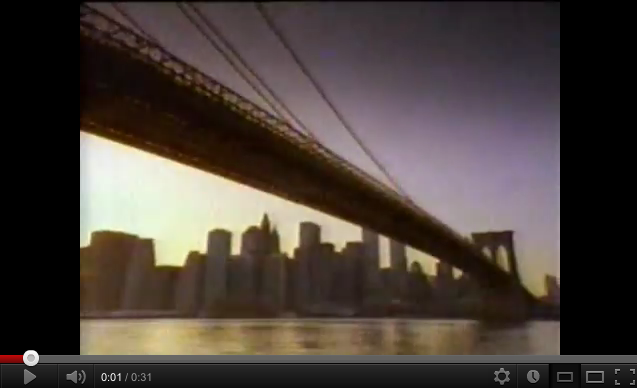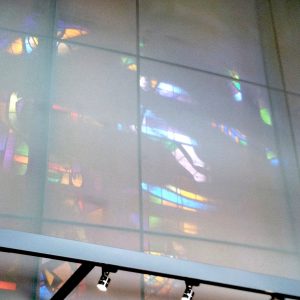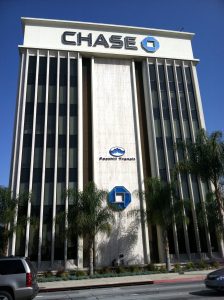Mary Baskerville Sheets: A Post for Mother’s Day
Millard Sheets cared deeply about his artwork, particularly his painting; he cared about his networks, and his ability to connect to people across career, political, or national divides; but he also cared deeply about his family, even when he was far from them. And these strands come together in the story of a painting, seen above, now hanging at the Parkway Grill in Pasadena.
Millard had known Mary’s older sister Elizabeth as a fellow student artist at the Chouinard Art Institute, and at a family dinner Millard met Mary. They hit it off immediately, I am told, but their lives seemed headed in opposite directions: Millard was gaining attention in New York and elsewhere for his paintings, and Mary was committed to her studies at UCLA (then called the Southern Campus of the University of California).
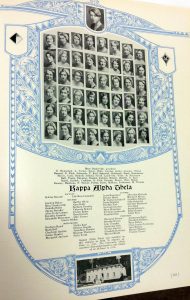
Kappa Alpha Theta Class of 1930, UCLA Archives. Mary Baskerville, the president of the sorority, is at top; Dorothy Grannis listed among the senior-class members.
Mary, an art major in UCLA’s teacher’s college, rose to be president of her sorority, Kappa Alpha Theta–and among its members in her class was Dorothy Grannis, later wife to Howard Ahmanson (suggesting occasions for an earlier connection between the two men than business breakfasts and a famous letter in 1953). Her presidency of the sorority Class of 1930 coincided with UCLA’s move to the newly constructed Westwood campus, and hence the building, funding, and decorating of the large new Greek houses in the neighborhood.
Millard wanted to get married, but Mary was also committed to finishing her degree — but in her last semester, in the spring of 1930, these two goals seemed impossibly opposed. Mary decided to leave school and marry Millard before his next trip East, to follow the whims of the art world. But there were also her duties to the sorority – how to placate them?
I am told this painting was the answer: a large oil
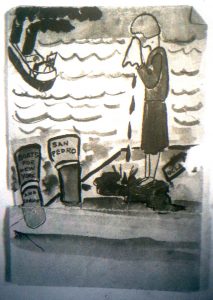
Mary Baskerville, crying self-portrait, 1929; Millard Sheets Papers, Archives of American Art, Smithsonian.
painting, showing a river landscape, given to the sorority in that spring of 1930, as the sorority president left to marry its artist. It hung for decades on the sorority walls, as a testament to the relationships between Millard and Mary, Mary and her sorority. The theme seems appropriate to such a moment of transition as it college — the crossing over of the river, the forking water path, and the question of what lies beyond, up upon those mountains.
It can now be seen amidst a wonderful collection of Millard’s paintings at the Smith Brothers restaurants in Pasadena. (UPDATE: I am told by Michael J. Johnson that a Giclée-on-canvas replica hangs in the sorority to this day. UPDATE 2: According to Susan Traister, who had the sorority’s paperwork on the transfer, “the Kappa Alpha Theta Sorority at UCLA owns it and loans it out to the Smith Bros.”) Perhaps that is the perfect place to celebrate Mother’s Day this year, and think about the interplay of family, art, and community for Millard Sheets.
Thanks to Carolyn Sheets Owen-Towle, Perry Jamieson, Christina Vader, and Bob Smith for providing/confirming elements of this story.
Panel Discussion and Home Savings Art exhibit
This week, I encourage one and all to come to the gallery show at the Grand Central Art Center in Santa Ana, showcasing the art of the Millard Sheets Studio at six Home Savings and Loan locations.
I will be presenting my research on a panel this Sunday, May 6, at 2:00 p.m., alongside noted architectural historian Alan Hess. I have been working with the exhibit organizers Concepcíon Rodríguez and Wendy Sherman for months, and I can guarantee this will be a great, ground-breaking show.
Join us!
Home Savings in New York – the TV Commercial
How did Home Savings/Savings of America express its affection for communities after they stopped paying for expensive artwork? Teresa Fernandez helped me again with a tip that some of the old Home Savings commercials can be viewed on YouTube.
Here, over a saxophone’s slow wail, images of multicultural New York flash by: the Brooklyn Bridge; a checker cab; Vesuvio Bakery; older (Italian?) men playing bocce ball; a baptism in a Catholic cathedral; a (Chinese?) girl whirling fans; a mother and son lighting Chanukah candles in the window; an African American band; an (Irish?) family dressed to parade with bagpipes; and then a return to those old men.
The commercial’s text, with pauses that make it feel like a poem, reads:
New York.
It’s a city
not just of people,
but of traditions,
that preserve the past
and enrich the present.
At Home Savings of America,
the nation’s largest savings bank,
we have a tradition
of conservative investing
that has made people like you feel secure.
for more than a hundred years.
In my mind, this is an exact continuation of the themes in Richard Haas’s Forest Hills mosaic and the general use of art and architecture to ground Home Savings, using quintessential (almost bordering on stereotypical) images of New York City and its traditional ethnic residents to express a sense of home, evoking personal routes and stories of migration through the city for those customers elsewhere, and a sense of pride for New Yorkers.
Home Savings put the tagline “Peace of mind since 1889” on its shield for many years — despite the fact that Howard Ahmanson only became the majority shareholder in the savings and loan in 1947. I see the same here, with a new bank determined to prove itself as an old, reliable friend. I find it very well done, the sentimentality full but not overdoing it, the “conservative investment” reassuring. And now, just like the mosaics, this 30-second commercial is now its own fascinating window on the past.
Home Savings in New York – Richard Haas’s Mosaic in Forest Hills
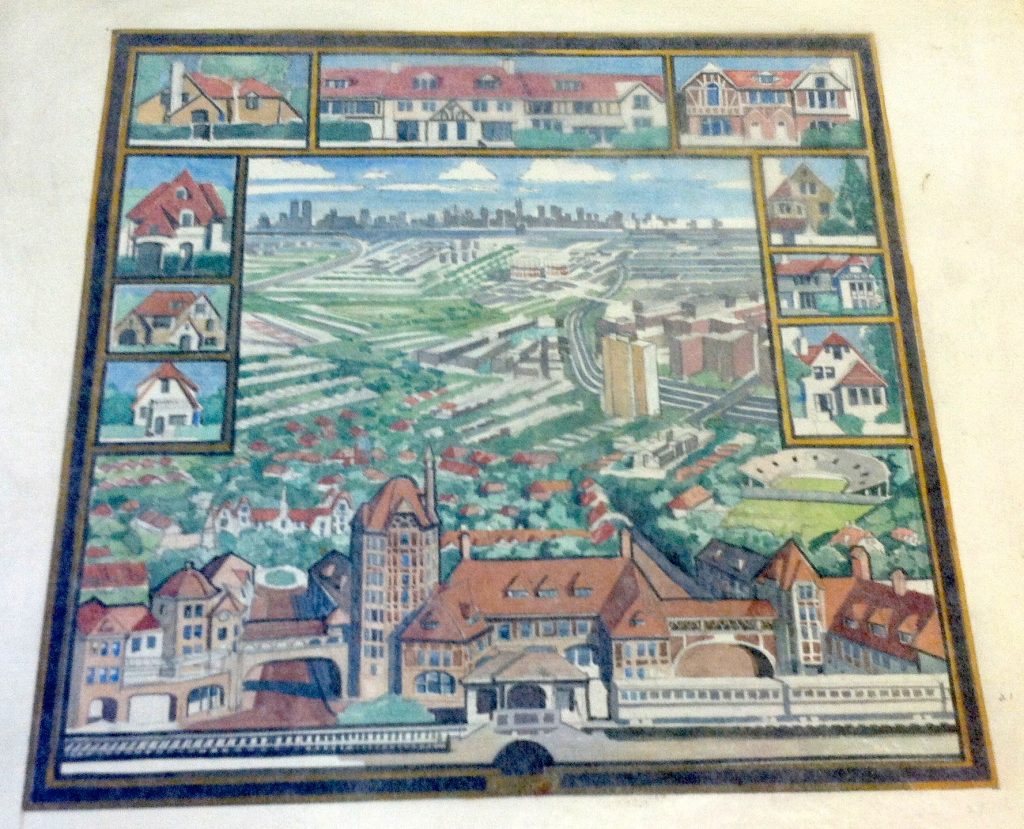
Richard Haas, sketch for Forest Hills branch, Savings of America, 1988-1989. My crooked image with permission of Richard Haas.
Over the past week I was far from Southern California, the part of the country most associated with Home Savings & Loan, in New York City.
Yet Home Savings (under the name Savings of America) expanded into New York, Illinois, Florida, Missouri, Ohio, and Texas in the 1980s and 1990s. The company worked to keep its brand assets in play there, with distinguished customer service but also distinctive buildings, with artwork that reflected the community. From the Denis O’Connor Papers, I have found some interesting conflicts between the local historical societies in these states and Home Savings, perceived as an outsider corporation. But the artwork did get done and installed in many of these locations.
There is one mosaic on a former New York Home Savings, in Forest Hills, at 108-36 Queens Blvd. It is by Richard Haas, an artist still active in New York City, who I had the pleasure of interviewing on my trip. Haas completed commissions for the 7th and Figueroa and Pasadena towers in Los Angeles, the Irwindale headquarters (all paintings) and designed mosaics for many of the Florida locations, with the mosaic fabrication done in Spilimbergo, in northeastern Italy. (He told me quite a story about the mural designed for Naples, Florida, that never got installed — the project was delayed, and the mosaic, all pasted to sheets, was put in storage. When they opened up the storage room to get the mosaics, they just found mounds of tiles — the industrious Florida insects had eaten the sugar paste off the paper, and destroyed the mosaic.)
Haas’s New York mosaic shows the Manhattan skyline in the distance, with the World Trade Center towers prominent; in between, the tracts of housing, tree-line streets, and larger developments create a patchwork. In a sign we are no longer in car-loving California, the bottom of the image is anchored by the historic Tudor-influenced train station nearby, for the Long Island Rail Road. Haas, a visual artist productively obsessed with the wonders of architecture, added house portraits of other local architectural gems to the upper corners, in the multi-view manner of 19th-century cityscapes.
Haas’s mosaic was installed on the curving facade of the Forest Hills Savings of America branch (shown here as a Commerce Bancorp branch, in 2007, before that bank’s merger). While, like so many Home Savings locations, this is a prominent corner, I am unaware of any other branches that have curving facades, instead of other approaches to the corner lot. The curve makes it hard to take in the full image as installed, so it is nice to have my rough photograph of the color drawing, above.
Haas’s work demonstrates how the Home Savings motif could translate to new locales such as New York. But this was the only mosaic completed for New York. Come back next week to learn about how some of the same themes were expressed in a different medium.
More Early Millard Sheets Public Art, and a Helping Hand

Millard Sheets, enamel panel of California (1 of 3), Mark Keppel High School, Alhambra, 1939. Photograph courtesy of Richard Yaussi
This week’s image comes from a fantastic new Flickr photostream by Richard Yaussi. In recent days I have been in touch with more Studio workers, social-media groups for former Home Savings employees, and individuals from all walks of life with more information to add to this research (and corrections for the list, which will soon get a makeover). I was even interviewed by a blog post about the San Jose Willow Glen Home Savings branch, and got an interview with a former branch employee in return, who helped save the interior murals when Washington Mutual wanted to paint them over.
I am thankful to continue to find such enthusiastic fans of this art and architecture, and my research on its place of Home Savings within the urban context of its communities!
This is Richard’s recent image of Mark Keppel High School in Alhambra, where enamel mosaics that Millard Sheets designed both echo some of the Home Savings work in their subject but differ dramatically in their style. (More on these panels, with photographs of all three, on the Alhambra Preservation Group site.)
These differences run through many of the early Sheets projects — some, like the 1954 centennial lithographs for American Trust Company (which was accompanied by an Ansel Adams book as well), seem to share the motifs and style of the later Home Savings bank work to a great extent, while others, like the Bullock’s Men Store mural reproduced in one of Sheets’s early art-show catalogs, seems radically different.
I recently found one of Millard’s résumés from 1963, when many of these early projects were still listed. Public, non-church buildings to be added to the “definitive” master list (and, in many cases, to be researched further) are:
Golden Gate International Exposition, San Francisco, CA, 1939, murals
Scripps College Art Building, Claremont, CA (date and specifics unknown)
Beverly Hills Tennis Club, Beverly Hills, CA (date and specifics unknown)
YMCA, Pasadena, CA, (date and specifics unknown)
Robinson’s Company, Los Angeles, CA, (date and specifics unknown)
South Pasadena Junior High School, South Pasadena, CA (date and specifics unknown)
Bullock’s Men’s Store, Los Angeles, CA (date and specifics unknown)
Air schools including Thunderbird #1 and #2 in Phoenix; Cal Aero, Ontario, CA; Air Cadet, St. Louis; Tex Rankin (flying) Schools, Visalia, CA; Dos Palos, CA; King City, CA; Uvalde, TX; Fort Stockton, TX (date and specifics unknown)
U.S. Department of Interior building, Washington, DC, 1946-1948, four panels on “The Negro’s Contribution in the Social and Cultural Development of America”
Lyman’s Restaurant, Los Angeles, CA, 1947-1948, glass mosaic
Melody Lane, Beverly Hills, CA, 1947-1948, puppet room
Beverly Hills Hotel, Beverly Hills, CA, 1947-1948, main lobby
Carnation Company offices, Hollywood, CA, 1948-1949
American Trust Company, Sacramento, CA, 1949, panels
Sequoia Room, Hody’s Lankershim, North Hollywood, CA, 1950
Mayo Clinic, Rochester, MN, 1953, mural on canvas
Pacific Clay Products (later Children’s Aid Society of California), 4th and Bixel, Los Angeles, 1953, interior design
Van Nuys Savings & Loan, Van Nuys, CA, 1954, mural on canvas
Bob’s Restaurant, Phoenix, CA, 1955, ceramic tiles on exterior
“The Springs” restaurant, Palm Springs, CA, 1956, three ceramic tile panels
Guaranty Savings and Loan, 2400 Broadway, Redwood City, CA, 1957 mural – painted over
Guaranty Savings and Loan, 200 Stockton St, San Francisco, CA, 1957, mosaic
St. Francis High School, La Cañada, CA, 1957, mural
First Federal Savings and Loan, Dallas, TX, 1958, mural
Bankers Life Insurance Company, Lincoln, NE, 1959, mural and mosaic
Tyler Bank and Trust, Tyler, TX, 1959, mosaic
Robert C. Wian Enterprises, Glendale, CA, 1960, executive offices – mosaic
Valhalla Mausoleum, North Hollywood, CA, 1960, mosaic
United Savings and Loan, Inglewood, CA, 1960, mural
Bankers National Life Insurance Company, Cincinnati, OH, 1960 interior mosaic
Victory Savings and Loan, North Hollywood, CA, 1960, mural
United Savings and Loan, Westchester, CA, 1960, mural
Willow Brook Country Club, Tyler, TX, 1962, mural
And of course information about these sites is much appreciated!
*
Your faithful historian/researcher/blogger will away for Passover, so the blog will not get a new post until around April 20.
Monument to Democracy, Statue of Liberty in the Pacific: Unbuilt Millard Sheets

Millard Sheets, sketch of Monument to Democracy for San Pedro, 1954. Courtesy of Alan Wofsy Fine Arts; my crooked image.
The L.A. Conservancy tour, like many of my efforts, focused on preserving the art and architecture of the Millard Sheets Studio, and to understanding what it has meant for its communities.
But, like all artists and architects, there are the projects that didn’t get built. And unbuilt projects can often be fascinating in their counterfactual, floor-moving-under-you way, a vision of a city unvisited yet so familiar.
This statue seems the biggest unbuilt project in the Sheets oeuvre: the Monument to Democracy, a 1954 effort spearheaded by LA County Supervisor John Anson Ford to build the Pacific Ocean’s “Statue of Liberty” companion in San Pedro.

Statue of Liberty replica in Guam. Photograph c. 2004 by Douglas Sprott under Creative Commons license Flickr
“The erection, on the West Coast, of an heroic statue to Democracy…is a project combining considerations of statesmanship, education and art, of profound international significance,” Ford wrote. Echoing age-old themes with a new Cold War twist, Ford declared,
The course of Democracy is moving westward. The great nations about the Pacific basin are looking across to America trying to discern whether our Democracy is really something for all, or is in effect a concept reserved for the Anglo-Saxon. Communism tries with cunning and skill to alienate all of darker skin from the ideals that motivate our Western society….When this project becomes a reality, as it certainly must, countless millions will find their way to it, there to be inspired by its majestic symbolism, and there to learn something of the unending story of how Democracy has inspired and blessed mankind.
Intended to be 480 feet tall, on a drum base 46 feet hight, topped with a bronze globe 125 feet in diameter, the Monument to Democracy was to have three figures, each 250 feet tall, on top of historical and art museums revealing the progress of each of the world’s races toward democracy. (I guess we are talking Asian, African, and European here — not a period of much considered of indigenous American peoples.) Millard Sheets was listed as the project’s designer, with the statue to be designed by his colleague, sculptor Albert Stewart.
This funding prospectus was circulating just as Sheets was completing his first project for Howard Ahmanson, the remodel of the National American Fire Insurance building, then at 3731 Wilshire (now the site of the Ahmanson Center).
If Sheets and Stewart were to have become wrapped up with this statue/museum project, how different southern California would look! One iconic statue, for good or ill, would have replaced the effort, history, and messaging that Home Savings received, to different ends.
John Wallis and Associates: Home Savings Stained Glass from Installation to Repairs
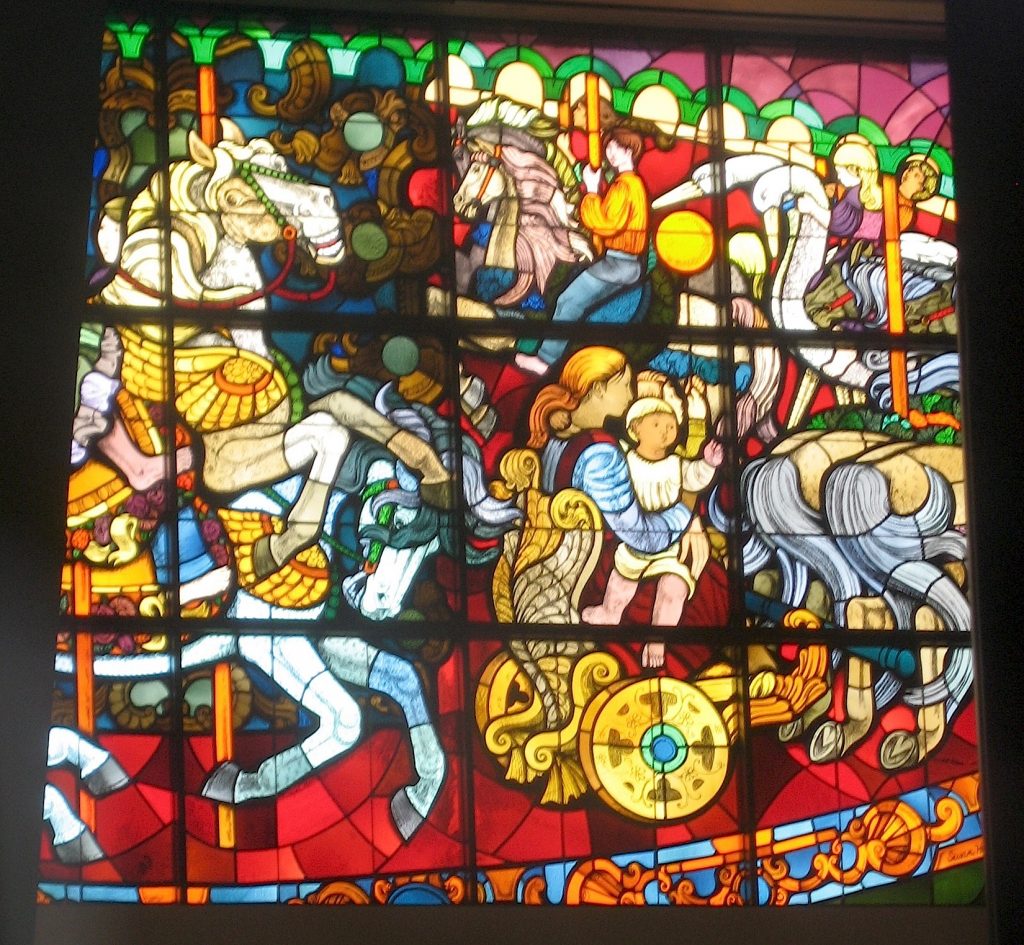
Sue Hertel and John Wallis stained glass, carousel (detail), Montebello, 1974. This site has been recently leased by a future good steward.
Last week I stopped into the Sunset and Vine branch of Home Savings. The mosaics look good, and the painted mural is mostly visible behind some cubicles. (As Tony Sheets mentioned this weekend, bank tasks change, and hence these spaces have had to evolve.) But it was the condition of the stained glass that stayed with me.
The Hollywood branch stained glass had some cracks, holes, or other damage–covered up with blue electrical tape! I introduced myself and told both the bank manager and Chase’s regional facilities manager who to contact for repairs: John Wallis and Associates stained glass.
In the current Huntington Frontiers magazine, I write about the marvels of the mosaic studio archives, from the time under both Millard Sheets and Denis O’Connor. But a visit with Susan Wallis, the current head of the stained glass firm and John’s daughter, and Helen Wallis, his widow, opened another window (pun intended) important for my research.
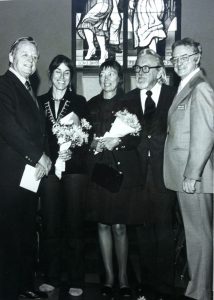
Millard Sheets, Sue Hertel, Helen and John Wallis and (bank official?) at an opening. Courtesy of John Wallis and Associates.
Building designs, mosaics, and painted murals were all done in-house at the Studio, and the archives are filled with Millard’s correspondence about furnishings, carpet, tile, and paint color, and other details. But like sculpture, stained glass was a skill outside of Millard’s direct purview. In the case of glass, it was Sue Hertel, armed with the designs approved by Millard, who came over to the Wallis-Wiley or then John Wallis studios to select the glass colors, approve the “waxed-up” temporary design, and to paint the final details onto the windows.
The discussion of repairs in the files is really fascinating, too. From the very first years, there was vandalism, settling, earthquakes, and accidents that led to cracks and holes, and (mostly in the case of the 1994 earthquake) whole panels falling out and needing to be replaced. Using the original instructions, the same materials, and the same methods, Susan Wallis has kept the windows in pristine condition, with no indication of what had been replaced.
As far as I know, none of the Home Savings stained glass windows have been removed, so going to see them is the best way to appreciate them. (Santa Monica, though, is now protected but obscured by a screen, and Beverly Hills are blocked by the new stairs.) Choose a sunny day, and go see these gems, like the Ahmanson Trust windows! (Details on where to find them in the list; contact me with needed updates.)
*
And – just another word of thanks to all those who came out to the L.A. Conservancy’s Mod Com tour and panel of Millard Sheets’ art and architecture last Sunday. The crowds and enthusiasm were great, and I enjoyed meeting so many of my correspondents, and seeing old friends in the cause.
If you have a memory, story, or question about the work of the Millard Sheets Studio or Home Savings, please do get in touch with me!
Millard Sheets Tour This Sunday!

Getting a head start on the tour! Visitors at the Millard Sheets Studio, Claremont, c. 1958. Courtesy of the family of Melvin Wood.
I am preparing my introductory slides and remarks for the L.A. Conservancy’s “Millard Sheets: A Legacy of Art and Architecture” tour this Sunday, March 18, so I won’t say too much here — except to encourage you to come!
The Conservancy has docents ready to explain seven sites in Claremont and Pomona with art and architecture from Millard Sheets, including his studio where much of the work was completed.
And then there is the 5:00pm panel, with sculptors Betty Davenport Ford and John Svenson, Sheets Studio architect Rufus Turner, Sheets Studio mosaicist Brian Worley, and two of Millard Sheets’s children, Carolyn Sheets Owen-Towle and Tony Sheets. And I am told many other individuals who worked in the Studio and on related art and architecture will attend as well.
This is a one-time-only set of events, so what are you waiting for? Buy those tickets now! See you Sunday!
Missing Home Savings Artwork: Wall Hangings from Huntington Harbor

Susan Hertel and Alba Cisneros, wall hanging for Torrance branch, Home Savings, 1980. Image courtesy of Alba Cisneros.
The vast majority of Home Savings’s distinctive art and architecture cannot be moved easily: mosaics; stained glass; giant painted murals; large sculptures; and the architecture of the buildings themselves. In a few cases, they have been torn down or painted over, but for the most part the artwork is in place, though at times hidden or damaged by changes to the bank’s layout, security, or convenience features.
But this week I want to focus on that which was movable from the Home Savings banks, and see if you my avid Internet audience might have ideas on where items are. There are some wood-panel murals that have been removed from the Pasadena Home Savings and the Pomona Buffum’s, as well as the mural from the Beverly Wilshire Hotel; these all seem to be safely maintained. There are the original Millard Sheets sketches for Home Savings projects, some of which are for sale by Alan Wofsy Fine Arts. And there are various commemorative brochures and prints offered at the openings of Home Savings in Beverly Hills and Hollywood, and Pomona First Federal in Claremont and Pomona; I have seen a number of each, some in library collections. There are calendars and advertisements too, with fascinating messages, which are harder to find — more on that in another post.
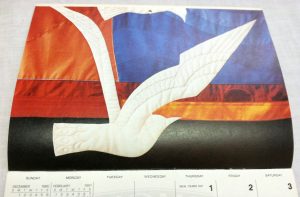
Susan Hertel and Alba Cisneros, wall hanging for Huntington Harbor branch, 1979, in 1980 Home Savings calendar. Image courtesy of John Wallis and Associates stained glass.
But what about these wall hangings, done for Huntington Harbor and Torrance, or the mosaic tables produced by the Millard Sheets Studio for Lakewood, the Van Ness branch in San Francisco, and the Arden Way branch in Sacramento? Can anyone say if any of those survive? (I also hear there is a version of the Home Savings shield done in stained glass for an Ahmanson Center corporate office; I am keeping track of these movables as I mull whether an exhibit might be possible alongside my book.)
The wall hangings are especially interesting, as they are more quilting or embroidery, rather than the tapestries that the Studio produced earlier for the Foley Communication Arts Center at LMU, as well as the Garrison Theater, produced in Aubusson, France. (It is unclear what kind of fabric art was in the Home Savings branches at Montebello and Mountain View as well.)
Alba Cisneros, who worked in the studio for many years, recalls having these wall hangings stretched out across her living room, sewing them quickly for the bank opening. Their theme and color palette, by Sue Hertel, reflect traditional Home Savings designs, but the new medium provides new textures and depth of color — as well as the portability that leads to the question of where they are.
Do you have leads on any of these items? Are any still in these banks? Have they been preserved? Do let me know.
Also: a REMINDER of the L.A. Conservancy’s Millard Sheets tour in Claremont and Pomona on Sunday, March 18, 10:00am-4:00pm. At 5:00pm there will be a panel discussion with Carolyn Sheets Owen-Towle (Millard’s daughter), sculptors Betty Davenport Ford and John Edward Svenson, architect Rufus Turner, and Studio mosaicist Brian Worley — and I will introduce the session with slides relating the tour sites to my overall research. I assume lots of others involved with this artwork will be there too. Hope to see you!
Home Savings Towers: Later Efforts at Distinctiveness
I have been on the Southern California freeways a lot recently–driving down to San Diego, out to Claremont, around and around the LA Basin, discussing my first book and finding new leads for Home Savings research. And though I have written before about the efforts to catalog what makes the Home Savings and Loan buildings distinctive, I have found another pattern worth noting: the Home Savings and Loan office tower.
The first Home Savings tower seems a fluke: it was built in 1962 as part of the downtown Pomona Mall redevelopment, a project that was a love note from Millard Sheets to his hometown, and something Howard Ahmanson and Home Savings seem to have joined as a favor to Sheets. The mall was toasted nationally as the future of urban renewal, and then faced its own decline — and now Chase has threatened the future of the tower as well. (Come tour the Pomona sites, and learn more from docents, a panel of Studio participants, and knowledgeable folks like me, at the L.A. Conservancy tour March 18th).
The tower was a one-off — Home Savings was not then in the business of building large office towers, nor of owning and managing commercial real-estate. And, because it may be the only Home Savings tower to have Sheets Studio art, I basically ignored the other towers for a while.
But I have been recently thinking about how the Home Savings brand was maintained by architecture even as the Sheets Studio branches changed (a topic for a future post), and I began to think more about the Glendale tower, and the Covina tower, and the one along the 405 in… Carson? Signal Hill? Clearly, Home Savings and Loan did become interested in tall office towers, likely for their commercial real estate space and their large branch spaces, after the S&L banking laws changed.
And of course it was nice that the towers could be their own Home Savings icons. These towers reflect the work of Frank Homolka for Home Savings, and their uniformity, with the space for the proud Home Savings name at the top and the shield along the shaft, created their own iconic recognition. (Here you can see Chase beginning to mimic this, with their logo on the side.)
Home Savings towers are in sight of the freeway, along the main streets of these suburbs, and hence often they are the only office tower of their kind in, say, Covina. This reflects a continuation of the Home Savings siting policies of the decorated branches. But the choice not to include Sheets Studio art, combined with the ubiquity of this generic, pared-down modernist architecture, suggests these towers no longer stand out from their postwar peers. But they do serve as a part of the story of art, architecture, and the urban context of Home Savings and Loan — if a subtle one.



